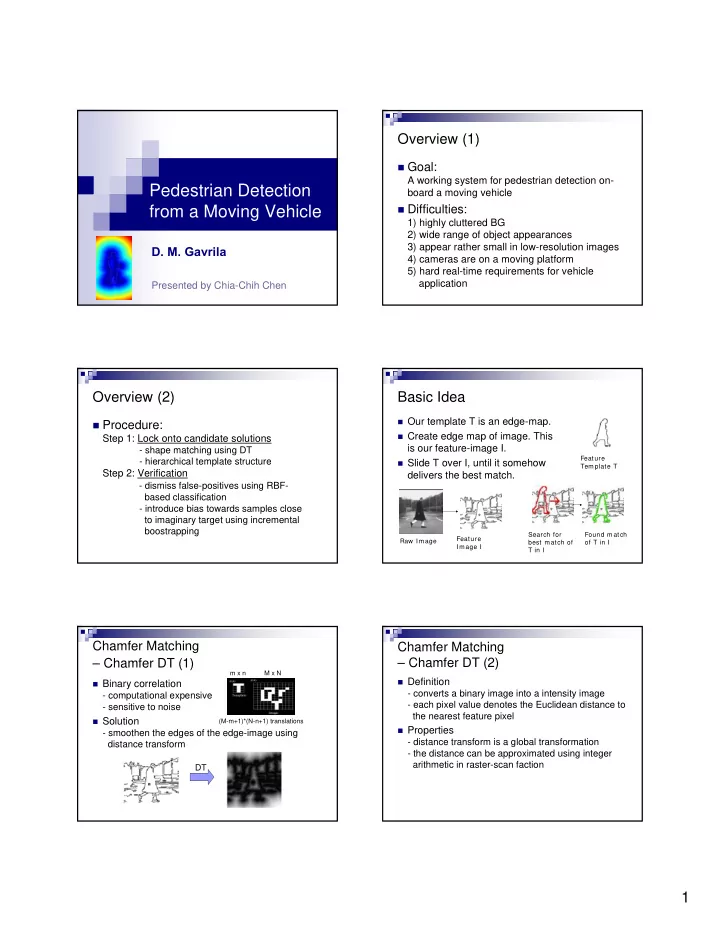

Overview (1) � Goal: A working system for pedestrian detection on- Pedestrian Detection board a moving vehicle from a Moving Vehicle � Difficulties: 1) highly cluttered BG 2) wide range of object appearances 3) appear rather small in low-resolution images D. M. Gavrila 4) cameras are on a moving platform 5) hard real-time requirements for vehicle application Presented by Chia-Chih Chen Overview (2) Basic Idea � Our template T is an edge-map. � Procedure: � Create edge map of image. This Step 1: Lock onto candidate solutions is our feature-image I. - shape matching using DT Feature - hierarchical template structure � Slide T over I, until it somehow Template T Step 2: Verification delivers the best match. - dismiss false-positives using RBF- based classification - introduce bias towards samples close to imaginary target using incremental boostrapping Search for Found match Feature Raw I mage best match of of T in I Image I T in I Chamfer Matching Chamfer Matching – Chamfer DT (2) – Chamfer DT (1) m x n M x N � Definition � Binary correlation - converts a binary image into a intensity image - computational expensive - each pixel value denotes the Euclidean distance to - sensitive to noise the nearest feature pixel � Solution (M-m+1)*(N-n+1) translations � Properties - smoothen the edges of the edge-image using - distance transform is a global transformation distance transform - the distance can be approximated using integer arithmetic in raster-scan faction DT 1
Chamfer Matching Chamfer Matching – – Chamfer DT (3) Average Chamfer Distance � Procedure � Relevant T is translated & positioned over DT(I) - Initialization - FW scan - BW scan � D(T, I) is determined by the pixel values of DT(I) which lie under the pixels of T translated T � T considered match when D(T,I)< θ 1 ∑ = − D ( , ) T I min t i Chamfer T ∈ i I V i,j = min (v i-1,j-1 +d 2 , v i-1,j +d 1 , v i-,j+1 +d 2 , v i,j-1 +d 1 , v i,j ) ∈ t T Ex: D(T, I) = 1/6*(4+3+4+3+3+3) = 3.33 DT(I) Chamfer Matching Chamfer Matching – Template Hierarchy (1) – Template Hierarchy (2) � Objective K groups: t 1 , t 2 , … , t N To organize templates hierarchically so that { S 1 , S 2 , …, S k } Partitional matching can be conducted efficiently Partition size K K prototypes: Clustering D ( t i , p k * ) � Approach { p 1 , p 2 , …, p k } arg min E - group similar templates together and represent S , S , ..., S 1 2 k them by a “prototype” template and a distance - T are moved between groups so that E is � Stopping criterion: minimum E-value minimized - tight grouping - lowers the distance threshold for matching � decrease the number of locations to be considered Chamfer Matching Verification – Template Hierarchy (3) � Objective D(T,I)< θ p1 ? Verify candidate solutions found in the detection phase � Given σ l Candidate solutions w/ T id and corresponding Y N N Sample w/ finer grid image locations � Procedures Adjust θ p to adapt higher resolution - extract bounding box of the template matched C Add children nodes - normalize the window for scale - employ RBF-based classification and fixed incremental boostrapping Unit grid μ element 2
Verification Verification RBF network (1) RBF network (2) � Classify an unknown ε � RBF centers - define by individual class likelihood: Apply agglomerative clustering in feature space of training data to find centers, which total class likelihood: are from K classes c k , k = 1…K (K = 1 in our case) � Classify an unknown instance ε normalized likelihood: - the distance from ε to each RBF centers is = ε − calculated by d Gi i - ε is assigned to the class with highest P k - d i is further transformed by R(•), which is controlled - ε is rejected if 1) P reject > all P k by a i and b i R(d i ) 2) highest P k is lower than a 1 threshold t d i a i b i Verification Results (1) - Incremental Boostrapping � Objective � Settings Train the RBF classifier to be more discriminant on - 1250 distinct pedestrian shapes the imaginary border of pedestrian class - 3-level hierarchy, 900 templates at leaf per scale - 5 scales were used Training set � Implementation improvements - oriented edge features Detector Classifier - template subsampling False-positives - multi-stage segmentation thresholds - ground plane constraints Results (2) Results (3) � Detection rates - 60-90% using Chamfer System alone - detect 85% pedestrians, conceding 10% false- positives combining w/ incremental boostrapping � Cumulative distribution - average Chamfer leaf root distance values from root to the correct leaf - used to determine θ p at different T levels 3
Conclusions References � Advantages � DM Gavrila, “Pedestrian detection from a moving vehicle," Proc. 6th European Conf. on Computer coarse-to-fine approach: Vision, 2000 WxHxK � reduce WxH, reduce K � U. Kressel, F. Lindner, C. W¨ohler, and A. Linz. � Problems "Hypothesis verification based on classification at - depends on reasonable segmentation unequal error rates," Proc. of ICANN, 1999 - effective at limited scales � C. Papageorgiou and T. Poggio. "A pattern - partial occluded pedestrian, night scenes classification approach to dynamical object � Improvements detection," Proc. of the International Conference on - multi-modal shape tracker Computer Vision, Kerkyra, Greece, 1999 - SVM 4
Recommend
More recommend